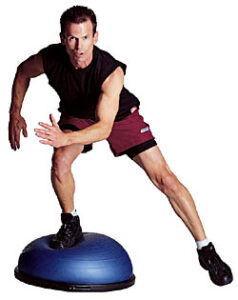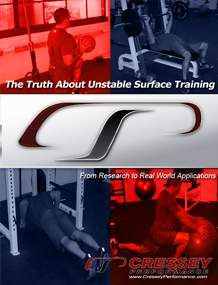Unstable Surface Training for Hockey
In a blog last week, I discussed how important it is to differentiate between unstable surfaces and destabilizing torques applied further up the kinetic chain, as they comprise different kinds of instability training.
I receive a great question in response to the blog:
“Eric, what do you think about unstable surface training for hockey? I’ve been using half-dome stability balls for a long time now in many settings (high school through college) with my trainers. I can’t tell if the effect wouldn’t be the same if I were doing something else but skates do wobble under weak players when pivoting and stopping quickly under loads up to 2-3 times body weight, and ankles do adjust to become more stable after training like this. What’s your experience? Thanks, Boris”
It’s an interesting case, as the blade of a hockey skate is certainly different than regular flat surface.
Even more interestingly, though, is that Boris – through his question and also his personal experience – has directly highlighted some important research that was done in this regard.
In 2005, Behm et al. (1) examined the correlation between hockey skating speed and performance on a 30-second wobble board test. Interestingly, they found a significant correlation in players under the age of 19. However, no such correlation existed with players age 19 and older. So, how does this occur?
Here’s an analogy: go to a little league park, and find the kids who have the best fastball velocity. Chances are that they are also the kids who run the fastest, jump the highest, do the most chin-ups – or any other physical test that you throw at them. Very simply, this difference can easily be attributed to different levels of motor development in young skaters. Heck, with just a quick Google search for “youth hockey,” I came across this picture.
You’ll notice that the physical development is markedly different across the board. In fact, the 6-4, 230-pound goalie drove all the other 11-year-olds to the game, taught them how to shave, and then hit on all the hockey moms after the game at the local bar.
Moving back to the aforementioned Behm et al. study, the researchers noted, “The complex skills associated with skating would necessitate a more refined balance that would improve with maturity and perhaps training. Since skating is performed on a very small surface area (blade) in contact with a low friction surface, younger individuals with greater stability may have an advantage in executing the specific skating skills” (1).
So, in reality, we’re comparing physical development and not necessarily performance on a specific test – until we level the playing field and physical maturity is roughly equal for everyone (after the age of 18). At that point, you don’t see a correlation, so I’d be very reluctant to endorse lower-body unstable surface training as a useful training implement for hockey outside of specific rehabilitation situations.
Also, to take this a step further, I need to make a clarification with respect to this statement from the original question: “ankles do adjust to become more stable after training like this.” This should actually be rephrased as “previously injured ankles do adjust to become more stability after training like this.” The truth is that nobody has really verified the incremental benefit of such training in healthy ankles (read: no previous history of injury) with a truly functional outcome measure.
The long-term studies examining the issue have been poorly controlled in the sense that they’ve looked at ankle sprains over the course of an extended period of time with an unstable surface training intervention, but haven’t taken into account previous history of injury. So, the athletes engaged in the unstable surface training group may simply have been rehabilitating previous ankle injuries with longstanding functional deficits rather than “fortifying” already healthy ankles to prevent injuries. Interestingly, in one study of elite female soccer players, balance board training did not decrease the rate of traumatic lower extremity injuries. The frequency of major injuries – including four of five anterior cruciate ligament tears – was actually higher in the intervention (unstable surface training) group than the control group (2).
For more information, check out my new e-book, The Truth About Unstable Surface Training.
References:
1. Behm, DG, Wahl, MJ, Button, DC, Power, KE, and Anderson, KG. Relationship between hockey skating speed and selected performance measures. J Strength Cond Res. 19(2):326-31. 2005.
2. Soderman, K, Werner, S, Pietila, K, Engstrong, B, and Andredson, H. Balance board training: prevention of traumatic injuries of the lower extremities in female soccer players: a prospective randomized intervention study. Knee Surg Sports Traumatol Arthrosc. 8(6):356-63. 2000.
New Blog Content
Random Friday Thoughts
Unstable Ground or Destabilizing Torques
Built for Show
That’ll do it for this newsletter.
All the Best,
EC





